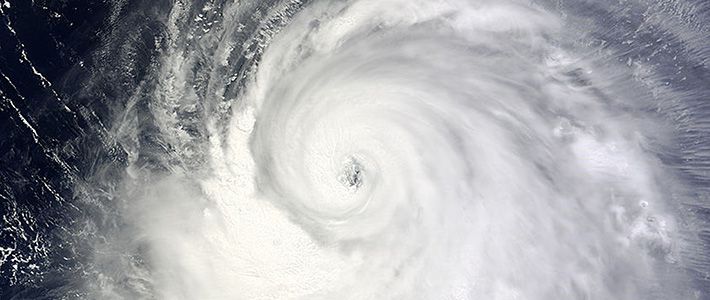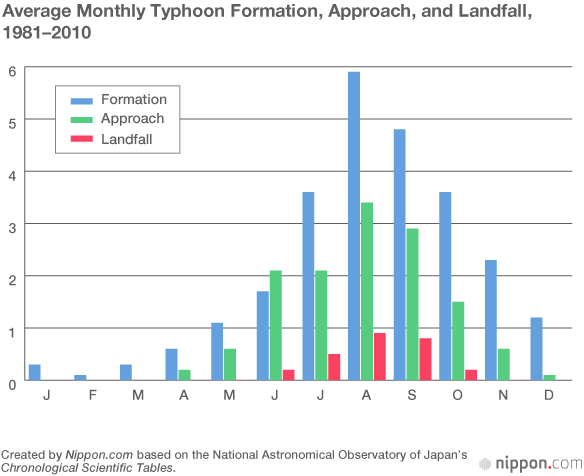
In the Path of the Storm: Japan and Typhoons
Society Lifestyle- English
- 日本語
- 简体字
- 繁體字
- Français
- Español
- العربية
- Русский
Typhoon Season
Typhoons are tropical depressions developing in the western part of the North Pacific Ocean with sustained winds over 17.2 meters per second (62 kilometers an hour). According to the Japan Meteorological Agency (JMA), the 30 years from 1981 to 2010 saw an average of 26 typhoons form annually, with three coming ashore along the Japanese archipelago in a typical year. Typhoons forming in lower latitudes in early spring typically follow a westerly path toward the Philippines; however, with the onset of summer, storms begin to make their way north along the edge of the taiheiyō kōkiatsu, or the North Pacific High, a seasonal subtropical ridge of warm air that, in a normal year, moves in from the Pacific and sits over Japan from mid-July to mid-September. Typhoon season, or when the largest numbers of storms approach the archipelago, is July–October, with most landfalls occurring in August and September. Flooding and other disasters sparked by torrential rains are common in September due to the formation of a seasonal frontal depression, known as the akisame zensen, which acts as a catalyst to intensify precipitation when typhoons move ashore.

Major Storms
Storms can wreak havoc with winds, torrential rain, storm surges, and waves; and the worst disasters are triggered when several or all of these combine. An average of two destructive storms have come ashore each year during the last 10 years, and on two occasions typhoons inflicted casualties of nearly 100 dead or missing. The chart below shows the extent of damage from major storms over the last decade.
Major Typhoons and Damage Since 2004
| Name and Japanese number | Areas affected | Principal damage | |
|---|---|---|---|
| October 2013 | Wipha (26) | Chūbu–Hokkaidō | 43 dead or missing; 130 injured; 1,094 homes damaged or destroyed; 6,142 homes flooded |
| September 2013 | Man-yi (18) | Kinki–Tōhoku | 7 dead or missing; 143 injured; 1,650 homes damaged or destroyed; 10,089 homes flooded |
| September 2011 | Roke (15) | All regions | 19 dead or missing; 337 injured; 3,739 homes damaged or destroyed; 7,840 homes flooded |
| August 2011 | Talas (12) | Shikoku–Hokkaidō | 98 dead or missing; 113 injured; 4,008 homes damaged or destroyed; 22,094 homes flooded |
| October 2009 | Melor (18) | All regions | 6 dead or missing; 133 injured; 2,387 homes damaged or destroyed;3,310 homes flooded |
| August 2009 | Etau (9) | Kyūshū–Tōhoku | 28 dead or missing; 29 injured; 1,173 homes damaged or destroyed; 5,217 homes flooded |
| September 2007 | Fitow (9) and others | Kinki–Hokkaidō | 3 dead or missing; 87 injured; 672 homes damaged or destroyed;1,345 homes flooded |
| July 2007 | Man-yi (4) and others | Okinawa–Tōhoku | 7 dead or missing; 83 injured; 295 homes damaged or destroyed; 3,993 homes flooded |
| September 2006 | Shanshan (13) | Okinawa and Kyūshū | 11 dead or missing;556 injured; 9,251 homes damaged or destroyed; 934 homes flooded |
| September 2005 | Nabi (14) and others | All regions | 29 dead or missing;179 injured; 7,452 homes damaged or destroyed;21,160 homes flooded |
| October 2004 | Tokage (23) | Okinawa–Tōhoku | 99 dead or missing; 704 injured; 19,235 homes damaged or destroyed; 54,850 homes flooded |
| October 2004 | Ma-on (22) | Kinki and Tōhoku | 8 dead or missing;169 injured; 5,553 homes damaged or destroyed; 7,843 homes flooded |
| September 2004 | Meari (21) | Okinawa–Tōhoku | 27 dead or missing;95 injured; 3,068 homes damaged or destroyed; 19,153 homes flooded |
| September 2004 | Songda (18) | All regions | 47 dead or missing;1,364 injured; 57, 466 homes damaged or destroyed; 10,026 homes flooded |
| August 2004 | Chaba (16) | All regions | 18 dead or missing; 285 injured; 8,627 homes damaged or destroyed;46,581 homes flooded |
| August 2004 | Aere (17) | Okinawa and western Japan | 4 dead or missing; 28 injured; 3,719 homes damaged or destroyed; 1,256 homes flooded |
| August 2004 | Megi (15) | All regions | 12 dead or missing;24 injured; 513 homes damaged or destroyed; 2,724 homes flooded |
| July 2004 | Namtheun (10) and others | Kyūshū and Kinki | 3 dead or missing; 17 injured; 113 homes damaged or destroyed; 2,215 homes flooded |
| June 2004 | Dianmu (6) and others | All regions | 7 dead or missing;116 injured; 180 homes damaged or destroyed; 202 homes flooded |
Notes: The JMA each year numbers typhoons sequentially; flooding figures include partially flooded homes.
Created by Nippon.com based on NAOJ’s Chronological Scientific Tables.
From June to November 2004, a record of 10 typhoons blew ashore, taking a massive toll on life and property as well as wreaking havoc on the agricultural, fishery, and forestry industries. Usually the Pacific High acts to deflect typhoons to the west, but that year the ridge moved higher north than usual, resulting in a typhoon “road” leading directly to the archipelago. The economic impact from this string of storms was enormous, with the three largest storms inflicting the greatest damage: Chaba causing ¥105.4 billion in damage, Songda ¥126.2billion, and Tokage ¥93.4billion.
The Three Great Shōwa Typhoons
From 1930 to 1950, Japan repeatedly suffered damage and loss of life from major storms. Three storms in particular, Muroto, Makurazaki, and Isewan typhoons—collectively known as the three great typhoons of Shōwa era (1926–1989)—were among the most violent and destructive.
| September 26–27, 1959 | Isewan typhoon | All areas except for Kyūshū | 4,697 fatalities; 401 missing; 38,921 injured; 833,965 homes damaged or destroyed; 363,611 homes flooded |
| Also called typhoon Vera, the storm had an atmospheric pressure of 929 hectopascals (hPa) when it came ashore and caused a record storm surge in Ise Bay. Damage stretched across the country, affecting 1.5 million residents. | |||
| September 20–21, 1934 | Muroto Typhoon | Kyūshū–Tōhoku | 2,702 fatalities; 334 missing; 14,994 injured; 92,740 homes damaged or destroyed; 401,157 homes flooded |
| The typhoon came ashore at Cape Muroto in Kochi Prefecture at 911.6 hPa. A four-meter storm surge and extreme winds in Osaka damaged and destroyed buildings, resulting in extensive loss of life. | |||
| September 17–18,1945 | Makurazaki typhoon | Western Japan | 2,473 fatalities; 1,283 missing; 2,452 injured; 89,839 homes damaged or destroyed; 273,888 homes flooded |
| The storm, at 916.3 hPa, blew ashore on the heels of Japan’s defeat in World War II. Unable to adequately prepare for the typhoon’s onslaught, many areas in western Japan suffered severe damage. Fatalities were particularly high in Hiroshima Prefecture. | |||
| September 25–27, 1954 | Tōyamaru typhoon | All areas | 1,361 fatalities; 400 missing; 1,601 injured; 207,542 homes damaged or destroyed; 103,533 homes flooded |
| After battering the lower regions of Japan as it moved north, the storm hit Hokkaidō at full force. Winds and high seas resulted in the capsizing of the ferry Tōyamaru off the port city of Hakodate. The tragedy resulted in 1,139 dead or missing. | |||
| September 26–28, 1958 | Kanogawa typhoon | Kinki region and areas further north | 888 fatalities; 381 missing; 1,138 injured; 16,743 homes damaged or destroyed; 521,715 homes flooded |
| Also known as super typhoon Ida, this immense storm blew ashore in Kanagawa Prefecture at an atmospheric pressure of 877 hPa. Torrential rains caused massive flooding in the Kantō area and on the Izu Peninsula. |
Motivated by the catastrophic damage of the three great Shōwa typhoons and other storms, the Japanese government has implemented nationwide measures over the years to mitigate damage from such phenomena as storm surges and flooding. Although no storms comparable in scale have struck Japan in the past five decades—outside of Okinawa, whose lower latitude places it squarely in the path of stronger typhoons—these measures have enabled the country to keep the level of destruction and loss of life far below what was suffered from earlier typhoons. This is illustrated by casualty figures from the deadliest storms for each decade since 1970: in 1976 typhoon Fran killed 169, typhoon Bess in 1982 claimed 95, and 62 died when typhoon Mireille struck in 1991. Into the 2000s, figures have stayed below 100 dead or missing for even the strongest storms.
The debate over the effects of global warming has intensified in the wake of destructive super storms, such as hurricane Katrina, which devastated the southeastern United States in 2005, and typhoon Haiyan, which pounded the Philippines in 2013. And some are saying that these stronger storms are the result of climate change. The JMA has disputed any possible correlation, saying there is no clear evidence that global warming is having an effect on the number or size of storms. The agency, however, participated in a research group that tested the potential effects of global warming by simulating temperature rises to the end of this century. The results of the experiment showed a trend toward fewer tropical storms, but also predicted an increased occurrence of bigger and stronger storms.
(Title photo: A NASA satellite image of typhoon Neoguri taken July 6, 2014. Photo courtesy of NASA/Reuters/Aflo.)
global warming damage typhoon climate change weather phenomenon